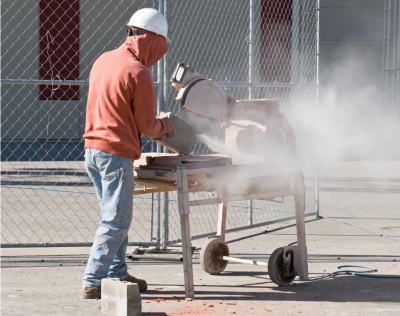Silicosis
What is Silicosis?
Silicosis happens when you breathe in dust from materials with silica. This dust gets stuck in your lungs, making them swollen and scarred. It also makes it hard for your lungs to take in air. This is called silicosis. It damages your lungs and can get worse over time, sometimes even leading to death.
Chronic silicosis usually happens after 10 years of breathing in silica dust, but it can happen faster with heavy exposure. Silicosis can continue even after you stop being exposed to it. There's no cure, and some people may need a new lung.
People who work with silica are also more likely to get tuberculosis, which is a dangerous infection. Breathing in silica can also cause other serious diseases like lung cancer, Chronic Obstructive Pulmonary Disease (COPD), kidney Disease, and autoimmune Diseases.
What Is Crystalline Silica?
Crystalline silica is very tiny dust that can go deep into your lungs. It's made when you cut, grind, or drill materials with silica in them. Things like sand, stone, concrete, and mortar have silica. It's also used to make glass, pottery, bricks, and artificial stone.
Who is at Risk from Silica Exposure?
People in various jobs, like construction, foundries, glass making, and mining, are at risk of breathing in silica dust. Construction workers engaging in tasks like cutting, drilling, and crushing concrete are at risk. The risk depends on how long they're exposed and how much silica dust they breathe in.
Types of Silicosis
- Acute: Happens quickly with high exposure, and it's severe.
- Accelerated: Comes after 5 to 10 years of exposure and can be severe.
- Chronic: Takes more than 10 years of exposure to develop and can be mild or severe.
Regular medical checks can find silicosis early so that workers can avoid more exposure and limit the disease. Healthcare providers who think a patient’s health problems are caused by their work conditions should report the case to their local or state health department.
Medical Monitoring
Doctors can check workers' health to see if they have silicosis or lung problems from silica dust. They use X-rays or CT scans to find it.
Preventive Measures
To avoid breathing in silica dust:
- Use water or vacuum tools to stop dust.
- Don't sweep dry, use wet methods.
- Wear the right gear (respirator and coveralls).
- Teach workers about the risks and safe ways to work.
- Get medical checks if you are exposed to silica dust.
Silicosis Symptoms
If you have these symptoms and were exposed to silica dust, see a doctor:
- Cough
- Hard time breathing or during an activity
- Chest pain
- Feeling tired
- Not hungry
- Losing weight
- Fever
- Skin turning blue or pale
- Swollen fingertips
- Lung infections
- Wheezing or chest sounds

